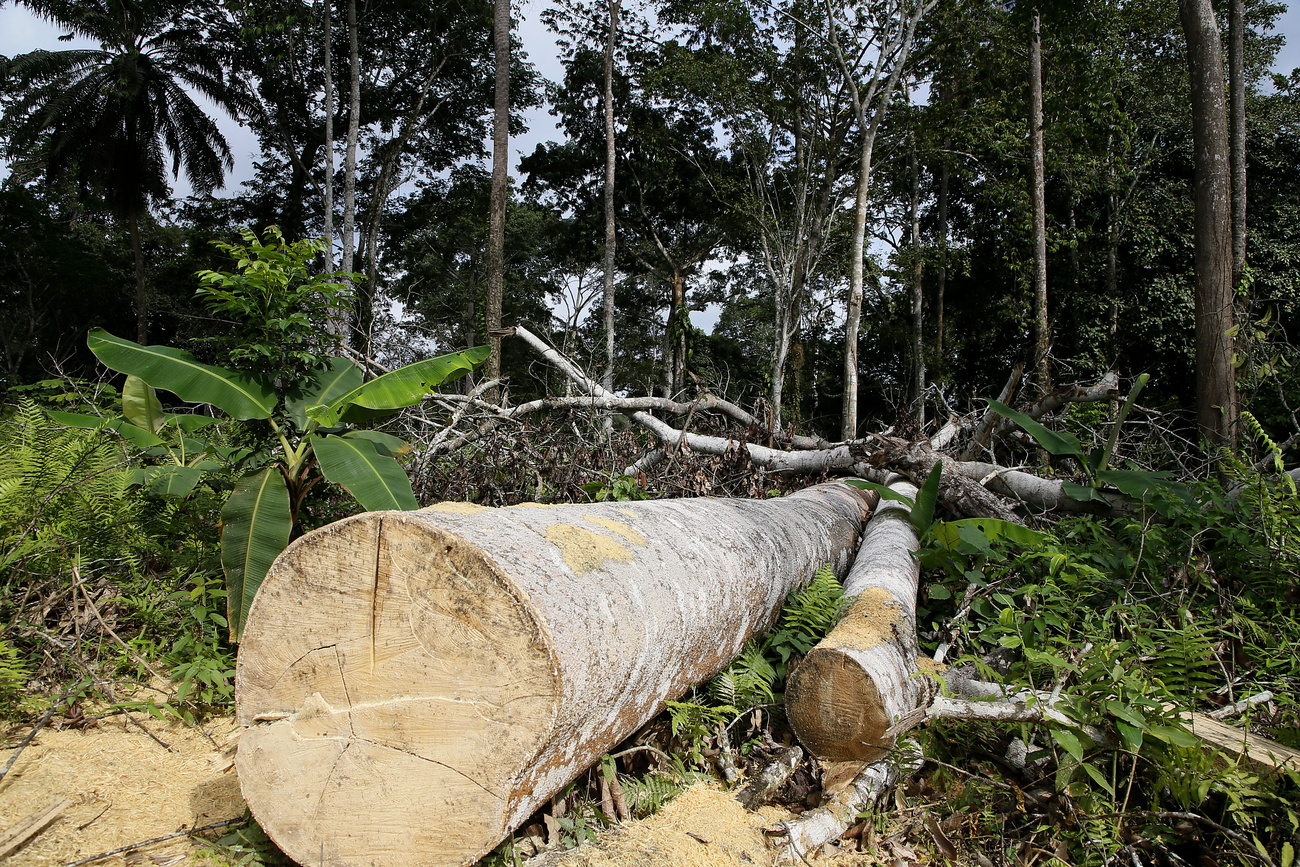
Deforestation flagged in West Africa despite chocolate industry’s promises

New data shows that forests are still being cleared for cocoa cultivation in Ghana and Ivory Coast despite commitments made by companies in 2019.
ResearchExternal link by American NGO Mighty Earth shows that Ivory Coast and Ghana have lost 2% and 3.9% respectively of their forest cover since a 2019 commitment made by the Cocoa & Forests Initiative (CFI) which counts Swiss chocolate manufacturers as partners. This loss in forest cover is equivalent to the size of Madrid, Seoul or Chicago.
Satellite data analysis and field visits revealed that Ghana lost 39,497 hectares of forest and Ivory Coast 19,421 hectares in cocoa-growing regions since 2019.
“The areas we visited are being deforested for cocoa. Most of the deforested sites already contain young cocoa plants,” Glenn Hurowitz, CEO of Mighty Earth told SWI swissinfo.ch.
While he admits that maize and other food crops such as tomato, papaya, eggplant are also grown in recently deforested areas, according to him their cultivation is not the primary goal of the farmers.
“They introduce these crops as a source of subsistence while waiting for the cocoa to mature,” he says.
Hurowitz adds that the cocoa grown in these cleared areas often ends up in cocoa cooperatives who have a supplier relationship with commodity firms like Cargill, Barry Callebaut, Olam, Sucden, Touton, and Ecom, who in turn supply cocoa beans to chocolate manufacturers like Nestlé and Lindt.
When contacted, the World Cocoa Foundation, that facilitates the Cocoa & Forest Initiative, declined to comment on the findings of the Mighty Earth report.
Vulnerable regions
As far as Ivory Coast is concerned, Guémon, the cocoa-growing heartland in the west of the country has seen a deforestation rate of 14% since 2019. The Mont Péko National Park located in this region has lost 350 hectares of forest in 2020 alone. However, it is less protected classified forests that have been most devasted by cocoa expansion. The government has decided to hand over parts of such forests for agroforestry schemes in the hope of restoring some tree cover in these areas.
In Ghana, the Ashanti and Ahafo regions have been hardest hit. They are also the major cocoa-growing regions of the country. There was also a spike in deforestation in 2020 in forest reserves and national parks.
“While government has a huge responsibility, let’s get real about who has the resources to act: Nestle’s annual revenue was CHF85 billion and Mars’ revenue was CHF37 billion. In contrast, Ghana’s annual government budget is CHF11 billion and Ivory Coast’s is CHF9 billion,” says Hurowitz.
Swiss commitments
In 2017, the governments of Ghana and Ivory Coast, as well as the biggest chocolate and cocoa companies (including Swiss firms) signed the Cocoa & Forests Initiative Frameworks for Action at the UN Climate Change Conference (COP23). In 2019, the signatories released action plans spelling out how they were going to halt cocoa-related deforestation.
In addition, Swiss companies have made individual commitments to end deforestation in their supply chains: Nestlé by 2020 and both Lindt & Sprüngli and Barry Callebaut by 2025.
Swiss food giant Nestlé did not achieve its zero-deforestation deadline of 2020 and now aims to source 100% deforestation-free cocoa by end 2025.
“To achieve this, we’re remodeling our sourcing to segregate and trace all the cocoa ingredients we buy, from origins to factory. We have already mapped the boundaries of more than 80% of the cocoa farms we source from directly in Ivory Coast and 95% of these farms in Ghana. This ensures our cocoa does not come from protected areas,” says a spokesperson.
Barry Callebaut is also trying to trace all its cocoa back to the farms so it can help identify if deforestation-linked cocoa ends up in its supply chain. In 2020/21, the company mapped 240,570 farms in their direct supply chain that are located within 25 kilometers of a protected forest area.
“With this information available, we were able to systematically reach out to relevant farmer groups and organizations in order to engage in measures that discourage deforestation,” says a spokesperson.

In compliance with the JTI standards
More: SWI swissinfo.ch certified by the Journalism Trust Initiative















![The four-metre-long painting "Sonntag der Bergbauern" [Sunday of the Mountain Farmers, 1923-24/26] had to be removed by a crane from the German Chancellery in Berlin for the exhibition in Bern.](https://www.swissinfo.ch/content/wp-content/uploads/sites/13/2025/12/01_Pressebild_KirchnerxKirchner.jpg?ver=f05a5a9c)















You can find an overview of ongoing debates with our journalists here . Please join us!
If you want to start a conversation about a topic raised in this article or want to report factual errors, email us at english@swissinfo.ch.